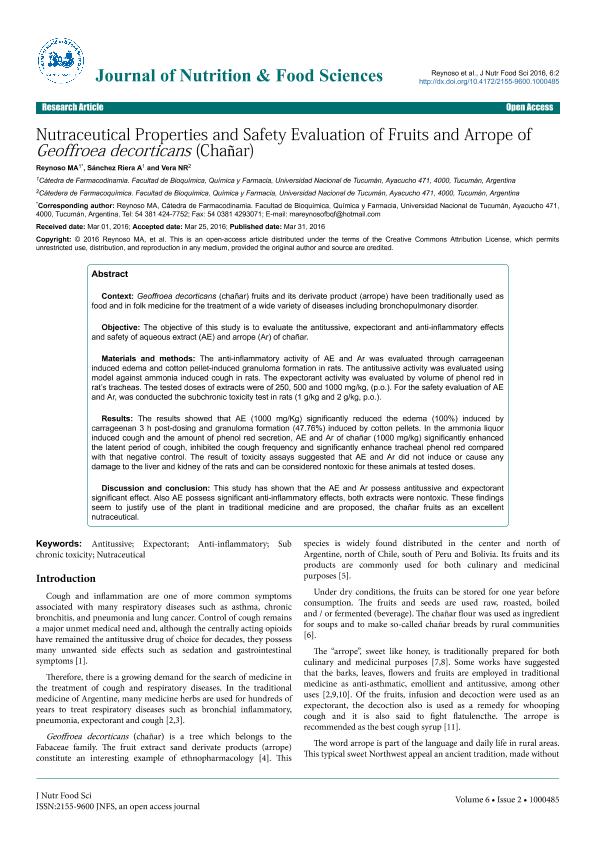Mostrar el registro sencillo del ítem
dc.contributor.author
Reynoso, Marcos Adrian

dc.contributor.author
Sanchez Riera, Alicia Noemi

dc.contributor.author
Vera, Nancy Roxana

dc.date.available
2020-06-25T13:38:06Z
dc.date.issued
2016-04
dc.identifier.citation
Reynoso, Marcos Adrian; Sanchez Riera, Alicia Noemi; Vera, Nancy Roxana; Nutraceutical properties and safety evaluation of fruits and arrope of Geoffroea decorticans (chañar); OMICS INTERNATIONAL; Journal of Nutrition & Food Sciences; 06; 02; 4-2016; 1-8
dc.identifier.issn
2155-9600
dc.identifier.uri
http://hdl.handle.net/11336/108180
dc.description.abstract
Context: Geoffroea decorticans (chañar) fruits and its derivate product (arrope) have been traditionally used as food and in folk medicine for the treatment of a wide variety of diseases including bronchopulmonary disorder. Objective: The objective of this study is to evaluate the antitussive, expectorant and anti-inflammatory effects and safety of aqueous extract (AE) and arrope (Ar) of chañar.Materials and methods: The anti-inflammatory activity of AE and Ar, was evaluated through carrageenan induced edema and cotton pellet-induced granuloma formation in rats. The antitussive activity was evaluated using model against ammonia induced cough in rats. The expectorant activity was evaluated by volume of phenol red in rat?s tracheas. The tested doses of extracts were of 250, 500 and 1000 mg/kg, (p.o.). For the safety evaluation of AE and Ar, was conducted the chronic toxicity test in rats (1 and 2 g/kg, p.o.).Results: The results showed that AE (1000 mg/Kg) significantly reduced the edema (100%) induced by carrageenan 3 h post-dosing and granuloma formation (47.76 %) induced by cotton pellets. In the ammonia liquor induced cough and the amount of phenol red secretion, AE and Ar of chañar (1000 mg/kg) significantly enhanced the latent period of cough, inhibited the cough frequency and significantly enhance tracheal phenol red compared with that negative control. The result of toxicity assays suggested that AE and Ar did not induce or cause any damage to the liver and kidney of the rats and can be considered nontoxic for these animals at tested doses.Discussion and conclusions: This study has shown that the AE and Ar, possess antitussive and expectorant significant effect. Also AE possess significant anti-inflammatory effects, both extracts were nontoxic. These findings seem to justify use of the plant in traditional medicine and are proposed, the chañar fruits as an excellent nutraceutical food.
dc.format
application/pdf
dc.language.iso
eng
dc.publisher
OMICS INTERNATIONAL
dc.rights
info:eu-repo/semantics/openAccess
dc.rights.uri
https://creativecommons.org/licenses/by-nc-sa/2.5/ar/
dc.subject
NUTRACEUTICAL
dc.subject
SAFETY
dc.subject
GEOFFROEA DECORTICANTS
dc.subject.classification
Otras Ciencias Biológicas

dc.subject.classification
Ciencias Biológicas

dc.subject.classification
CIENCIAS NATURALES Y EXACTAS

dc.title
Nutraceutical properties and safety evaluation of fruits and arrope of Geoffroea decorticans (chañar)
dc.type
info:eu-repo/semantics/article
dc.type
info:ar-repo/semantics/artículo
dc.type
info:eu-repo/semantics/publishedVersion
dc.date.updated
2020-06-23T13:09:26Z
dc.journal.volume
06
dc.journal.number
02
dc.journal.pagination
1-8
dc.journal.pais
Estados Unidos

dc.journal.ciudad
New Jersey
dc.description.fil
Fil: Reynoso, Marcos Adrian. Universidad Nacional de Tucumán. Facultad de Bioquímica, Química y Farmacia; Argentina
dc.description.fil
Fil: Sanchez Riera, Alicia Noemi. Universidad Nacional de Tucumán. Facultad de Bioquímica, Química y Farmacia; Argentina
dc.description.fil
Fil: Vera, Nancy Roxana. Universidad Nacional de Tucumán. Facultad de Bioquímica, Química y Farmacia; Argentina
dc.journal.title
Journal of Nutrition & Food Sciences
dc.relation.alternativeid
info:eu-repo/semantics/altIdentifier/url/http://www.omicsonline.org/nutrition-food-sciences.php
dc.relation.alternativeid
info:eu-repo/semantics/altIdentifier/doi/https://dx.doi.org/10.4172/2155-9600.1000485
Archivos asociados
